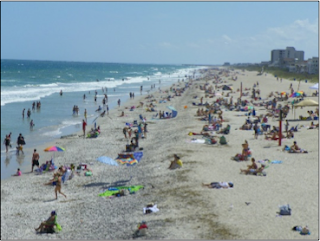Tourism and Power in the OBX
Hayley Grabner is a candidate of the Masters of Coastal & Ocean Policy program at UNCW. She earned a B.S. in Environmental Biology from Appalachian State University in 2013 and has since worked in wilderness guiding, environmental education, and adventure recreation. She is currently the Education & Outreach intern for City of Wilmington Stormwater Services.
The cooler is packed, the gas tank is full, the GPS is programmed and the countdown has begun. The boogie boards are in-between the bicycles, the umbrellas are in-between the boogie boards, and it’s not even light outside yet. You’re caffeinated and ready to go – you’ll buy the rest when you get there.
 For thousands of families nationwide, packing up and heading off to the beach for a week of sun, sand and surf is a familiar summer ritual. Particularly for families from New England to the Midwest, there is a good chance that North Carolina beaches are the annual destination. In fact, 54.6 million people visited North Carolina in 2015, ranking it 6th highest in visitation by state. Of that figure, roughly 8.8 million were headed to the states 3,375 miles of shoreline. While the state’s beaches all enjoy a tourism influx during the summer months, Dare County pulls the majority. This is because Dare County is home to the Outer Banks (OBX): a 200-mile network of barrier islands flanked by large, estuarine sounds on one side, and pristine, Atlantic beaches on the other.
For thousands of families nationwide, packing up and heading off to the beach for a week of sun, sand and surf is a familiar summer ritual. Particularly for families from New England to the Midwest, there is a good chance that North Carolina beaches are the annual destination. In fact, 54.6 million people visited North Carolina in 2015, ranking it 6th highest in visitation by state. Of that figure, roughly 8.8 million were headed to the states 3,375 miles of shoreline. While the state’s beaches all enjoy a tourism influx during the summer months, Dare County pulls the majority. This is because Dare County is home to the Outer Banks (OBX): a 200-mile network of barrier islands flanked by large, estuarine sounds on one side, and pristine, Atlantic beaches on the other. Dare County is also one of the twenty counties in North Carolina governed by the Coastal Area Management Act of 1974 (CAMA). Among several specific objectives, CAMA mandates “wise use of land and water resources... to preserve, protect, develop, and enhance the nation’s coastal zone for this and succeeding generations.” Since tourism and the associated development can absolutely be considered a “use” of the land and water resources, it is then necessary to consider the “wise-ness” of tourism and the impact it has on the region environmentally, economically, and culturally for the CAMA mandate of wise use to be achieved.
Even in the earliest days, tourism was a dominant force driving OBX economic development. Right away, locals knew to take advantage of the economic window of opportunity and began to capitalize on the demand to provide tourists with needed goods and services. Tourism in the 1800-1900s was driven largely by hunting, fishing, and recreation. Early visitors sought seclusion and simplicity, which were a sign of prestige.
Today, the profile of the average OBX beach goer looks much different. While still an indicator of wealth, tourists no longer appear to seek solitude or cultural emersion. Now, the focus is on relaxation and amenities. As a result, giant beach houses, Costco-sized packages of hotdog buns, and improved technology have brought more people to OBX than ever. Aside from infrastructure, this also has a big impact on the pristine land and water resources of the Outer Banks.
But, to what extent is it being addressed by the ‘wise use’ clause of CAMA?
Undeniably, tourism has a huge economic impact on the state, accounting for 21.9 billion in spending in 2015. Once again, the bulk of this is generated at the coasts particularly Dare county, which consistently boasts the highest per capita tourism revenue by a large margin. Many local and state agencies pour millions of tax and private dollars into promoting tourism, annually. This is guided by the common social narrative that, in the words of the Dare County Tourism Board, “tourism means jobs and paychecks, and because of the taxes paid by visitors while they’re here, we [locals] even enjoy significant tax relief.” However, local, working-class residents prove to be less likely to agree with this statement than tourists, and much less likely to agree than government officials. Instead, many locals are experiencing difficulties affording housing in vacation areas where their jobs are because property values have sky rocketed with new development, yet part-time seasonal earnings appear stagnant.
 |
| Data from US Census Bureau |
Environmental and social concerns are also rising faster amongst the local population, but are becoming prevalent with visitors, too. According to a National Geographic travel expert [JW1] quoted in the Virginian-Pilot, “with giant houses taking over the horizon and chain restaurants and stores replacing the quirky mom-and-pop establishments on the Outer Banks, tourists are taking note.” In other words, it is not just the amenities, and sandy beaches that tourists flock for; it is also the rich natural and cultural heritage and local flavor that make OBX unique and desirable.
Without a thriving local community, environmental protections, and a political process that represents all stakeholders, policymakers are failing to achieve wise use of the land and water resources of OBX. As the void grows between values of locals, tourists, and decision makers, agencies like NC Chamber of Commerce and OBX Visitors’ Bureau need to start promoting more than just visitation and spending. It is time to abandon the “trickle down” tourism-economic model and directly invest in what makes the region special: the people, the culture, and the natural landscape, in order for wise use and a sustainable tourism industry to be achieved.




Comments
Post a Comment